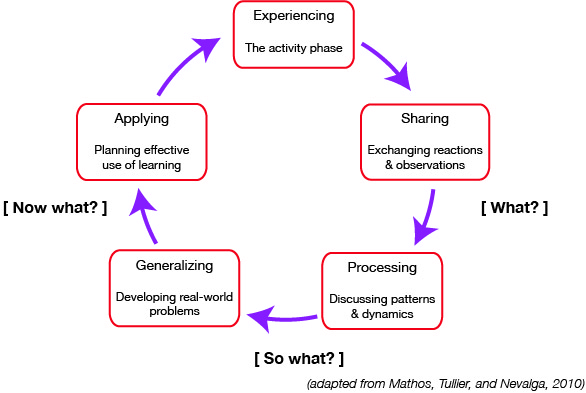As John Dewey observed, we do not learn from experience so much as we learn from reflecting on experience. It is reflection that connects theory to practice and generates the breakthrough moments that bring learning to the next level.
The four key principles of reflection are that it is:
- continuous, occurring both before and after a student’s experience,
- connected to both academic content and personal development,
- challenging enough to critically engage participants in the issues, and
- contextualized to the content of the course (Eyler, Giles, & Schmiede, 1996).
The deepest learning occurs with reflections that are part of a reflective classroom environment, rather than just a reflective component that has little relation or effect on the other components of a class.
Reflection comes in many forms, including writing, telling (presentations and discussions), responding (to peers or materials relating to issues being reflected upon), and doing (culminating projects). The various forms of reflection used in a course should provide opportunities throughout the semester for students to think about three key questions: what?, so what?, and now what? It is critical that students have structured opportunities to address all three stages of thought. It is only at the now what? stage that experiences can be converted into learning and growth, but students typically need a teacher’s guidance to reach this stage.

While reflection is sometimes thought to be suitable only as an informal activity, separate from major assignments and accorded little or no weight in students’ grades, critical reflective thinking can in fact be incorporated into nearly every aspect of a course, including existing assignments. Lab work, group work, field experiences, and reading assignments can all lend themselves to critical reflection when purposefully done.
Service-Learning is a form of experiential learning particularly suited to reflection. It intentionally links course learning objectives to direct or project-based service with community partners that both contributes to student learning and meets a community need. At Northeastern service-learning is found in a variety of courses and forms: for example, Biology students work with area youth to learn the fundamentals of science, students in Advanced Writing develop content for organization newsletters and websites, and students in Communication Studies courses conduct research with partners to discover how to better connect with their clients. Each of these opportunities lends itself to deep learning through both experience and reflection, bringing the course objectives to life for students.
You can learn more about Service-Learning by visiting Northeastern’s Community Engaged Teaching and Research website.
References
Eyler, J., Giles Jr., D. E., & Schmiede, A. (1996). A practitioner’s guide to reflection in service-learning: Student voices & reflections. Nashville, TN: Vanderbilt University.
Mathos, E., Tullier, S., and Nevalga, A.D. (2010). Presentation from Michigan Campus Compact 2010 Meeting.
